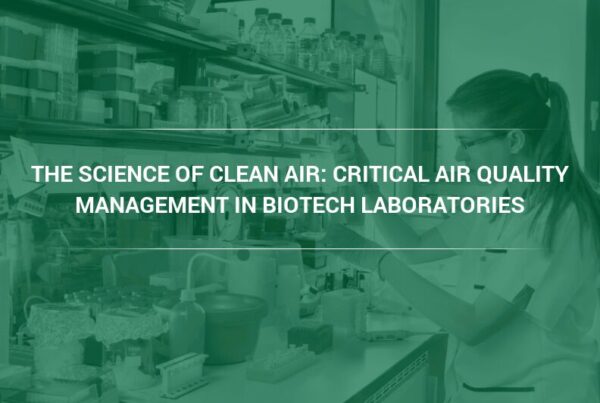Breathing is often overlooked but plays a vital role in optimizing workout performance. Proper oxygen intake fuels the body and supports sustained energy, aiding muscle growth and recovery. However, the quality of the air being inhaled matters just as much as breathing technique.
This article examines the importance of indoor air quality (IAQ) in campus fitness centers. Poor IAQ can hinder performance, increase fatigue, and even pose health risks for students and staff. Ensuring clean, well-circulated air in these spaces is essential for creating a safe and effective environment for fitness and wellness.
The Importance of Physical Activity for College Students
Physical activity plays a crucial role in the overall well-being and academic success of college students. Incorporating movement, such as yoga, weightlifting, running, dancing, and team sports, into daily routines has been linked to:
- Improved sleep quality [1]
- Higher energy levels, lower fatigue, and an enhanced sense of vitality [2]
- Increased productivity and cognitive performance [3]
Regular exercise can even be as or more effective in treating mild to moderate symptoms of depression as selective serotonin reuptake inhibitors (SSRIs), a common first-line medication for depression. Exercise in combination with these medications has been shown to increase its effectiveness in individuals with and without comorbid diagnoses [4]
For college students adapting to new environments and intense workloads, physical activity acts as a critical tool to sustain balance and resilience, therefore reducing overall psychological success. With a healthy environment in which to engage in regular exercise, students can develop healthier habits that contribute to long-term academic and personal success.
How Bad Air Quality Impacts Athletic Performance
Numerous studies highlight the detrimental effects of air pollution, not only outdoors but also indoors in recreational settings. Poor air quality can:
- Decrease endurance due to the presence of fine particulate matter (PM2.5) that restricts lung function.
- Slow reaction times and reduce cognitive focus, especially during high-intensity workouts [5]
- Diminish long-term athletic performance, leading to severe respiratory strain or inflammation. [6]
For the broader student body, these effects can offset the positive effects of exercise and make the overall experience unpleasant, therefore reducing students’ motivation to maintain healthy physical activity. Regular exercise is an important aspect of maintaining a healthy lifestyle, but when done in polluted environments, it can have negative consequences on students’ health and well-being.
Implications of Poor IAQ for Student Athletes
For student athletes, the stakes are particularly high. Poor IAQ jeopardizes:
- Performance Stability: Air pollution impacts both aerobic accomplishments and strength-based activities [5]
- Recovery Rates: Contaminated environments elevated with carbon particulates increase oxidative stress in the body, delaying muscle recovery.
- Long-Term Lung Health: Exposure to pollutants may render athletes more susceptible to chronic respiratory conditions later in life [6]
A 2024 study conducted by researchers at Brown University examined 16 years of marathon runners’ finish time data—encompassing several million data points—and concluded that exposure to PM2.5 during a race was significantly correlated with slower finish times. [6]
Students who train in compromised air frequently find it harder to meet their full athletic potential within the safety of campus facilities. Because of its impact on individual athletes’ overall health and athletic performance, poor IAQ may impact a team’s standing in their NCAA division.
Common Pollutants in University Gyms and Recreational Spaces
While you might not think that air pollution is a cause for concern in your school’s fitness center, indoor air pollution in these environments is surprisingly common and often goes unnoticed.
Indoor pollutants in fitness centers typically originate from both internal and external sources and are dependent on several factors, including geographic location and other uses of the building. A university recreation center at a large school housed in its own building in close proximity to a highway, for example, will have different pollution concerns than a smaller fitness center in a rural location housed in the same building as a dining hall or dormitories.
Pollutants often include:
-
- Particulate Matter from overcrowded spaces, poor ventilation systems, and outdoor sources.
- Dust and Allergens generated by heavy traffic on gym flooring or unclean HVAC systems.
- Airborne Pathogens that can lead to increased infection rates of illnesses such as COVID-19 across campus
- Volatile Organic Compounds (VOCs) emitted from cleaning solutions, rubber mats, and worn-out exercise equipment.
Although these pollutants might seem harmless initially, their accumulation can contribute to nausea, breathing difficulties, and even long-term cardiovascular issues.
Solutions to Improve IAQ in University Fitness Centers
Ensuring clean, breathable air starts with proactive measures to integrate healthier practices. These strategies can include:
1. Upgrade Your HVAC System
Efficient ventilation systems are critical for removing stale air, maintaining optimal oxygen levels, and blocking external pollutants.
2. Install High-Efficiency Air Filters
Using HEPA filters and high MERV-A rated filters in air filtration systems can trap harmful particles like viruses, bacteria, PM1 and PM2.5 particles, safeguarding both students and staff.
3. Use Air Quality Monitors
Real-time monitoring devices can flag sudden spikes in pollutants, allowing for immediate corrective actions.
4. Consider Chemical Use
Keeping equipment clean is important for safety and hygiene in fitness centers, but harsh cleaning chemicals emit VOCs that cause both immediate and long-term respiratory health impacts. Adopting environmentally-friendly and/or low VOC cleaning supplies can help mitigate this risk, but air filters designed to control molecular contaminants (sometimes referred to as molecular or gas-phase filters) provide that extra layer of protection that could allow the athlete to perform at their highest level.
5. Consult with an Air Filtration Specialist
Professionals can provide tailored solutions after conducting audits, identifying specific IAQ concerns, and suggesting interventions aligned with fitness center needs. Summer presents a unique opportunity for university facilities managers to initiate strategic changes, such as implementing premium air quality solutions, with relatively little interruption to campus life.
READ MORE: Why Summer Is the Smartest Time for HVAC Filter Changeouts in Schools and Universities
Prioritizing IAQ is Essential for a Healthy Campus
At universities, recreation and fitness centers aren’t just facilities; they are hubs where students recharge, connect, and improve both mental and physical health. By prioritizing IAQ, universities demonstrate a commitment to their community’s well-being while empowering students to achieve their fitness aspirations.
Take your next step toward cleaner, healthier indoor environments by consulting an air quality specialist. Together, you can craft a healthier future for campus fitness.
About Camfil
The Camfil Group is headquartered in Stockholm, Sweden, and has 29 manufacturing sites, six R&D centers, local sales offices in 35+ countries, and 5,700 employees and growing. We proudly serve and support customers in a wide variety of industries and communities across the world. To discover how Camfil USA can help you to protect people, processes, and the environment, visit us at www.camfil.us.
Sources:
[1] Alnawwar, M. A. (2023). The effect of physical activity on sleep quality and sleep disorder: A systematic review. Cureus, 15(8). https://doi.org/10.7759/cureus.43595
[2] Wender, C. L. A., Manninen, M., & O’Connor, P. J. (2022). The Effect of Chronic Exercise on Energy and Fatigue States: A Systematic Review and Meta-Analysis of Randomized Trials. Frontiers in Psychology, 13(13). https://doi.org/10.3389/fpsyg.2022.907637
[3] Davidson, M. (2023, June 6). The Hidden Benefits of Clean Air: Exploring the Link Between Better Indoor Air Quality and Improved Productivity. Camfil Clean Air Blog. https://cleanair.camfil.us/2023/06/06/the-hidden-benefits-of-clean-air-exploring-the-link-between-better-indoor-air-quality-and-improved-productivity/
[4] Noetel, M., Sanders, T., Gallardo-Gómez, D., Taylor, P., & Cruz, B. del P. et al. (2024). Effect of exercise for depression: Systematic review and network meta-analysis of randomised controlled trials. The BMJ, 384. https://doi.org/10.1136/bmj-2023-075847
[5] Maldarelli, C. (2025, February 28). How Bad Air Quality Slows Down Marathon Runners. Scientific American. https://www.scientificamerican.com/article/how-bad-air-quality-slows-down-marathon-runners/
[6] Fleury, E. S., Bittker, G. S., Just, A. C., & Braun, J. M. (2024). Running on Fumes: An Analysis of Fine Particulate Matter’s Impact on Finish Times in Nine Major US Marathons, 2003–2019. Sports Medicine, 55. https://doi.org/10.1007/s40279-024-02160-8



